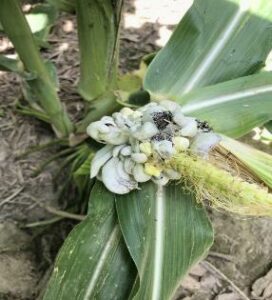Common Smut

Common smut, caused by the pathogen Ustilago maydis, is common in corn-growing areas, but it rarely results in major yield losses and does not produce mycotoxin. While it is not an ear rot, it is often mistaken as one.
Symptoms: Abnormal growth (galls) may develop anytime throughout the growing season on stalks, leaves, or tassels but is most easily recognized when they develop on the ear replacing kernels with abnormal bluish- silvery tissue that is fleshy to the touch. Later within the season, black teliospores of this fungus bust out of the abnormal growth. Young, actively growing tissue are especially susceptible to this disease.
Favorable conditions: Conditions that interfere with pollination may favor infection of ears. Common smut is the most severe type of smut when young tissue is injured by hail, wind, or mechanical damage. Poor pollination and excessive nitrogen fertilization, as well as rainy, wet weather, can exacerbate this disease.